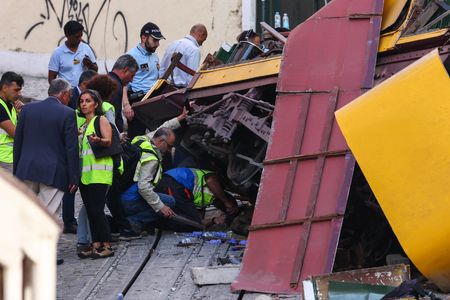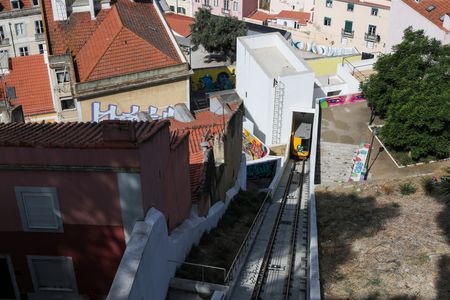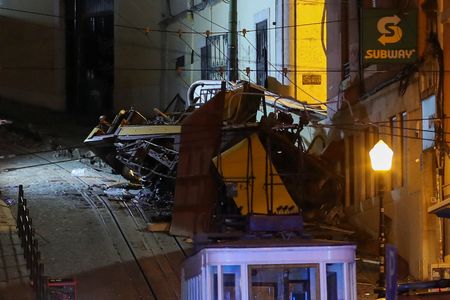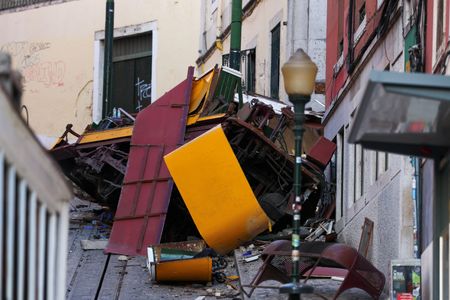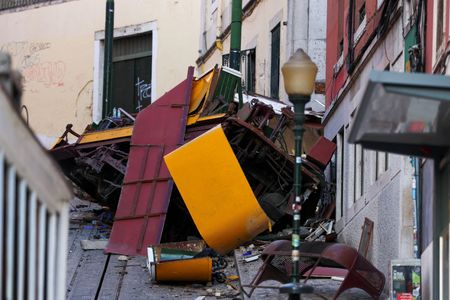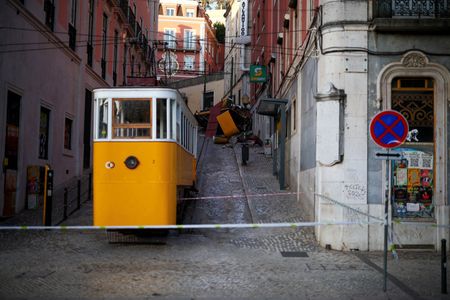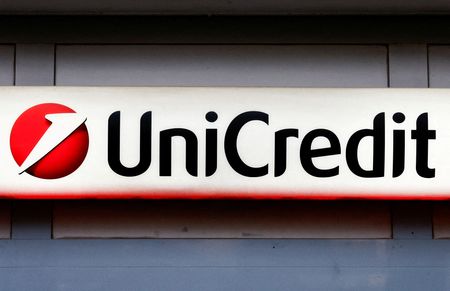By Sergio Goncalves and Andrei Khalip
LISBON (Reuters) -Portuguese authorities were investigating on Thursday what caused a Lisbon funicular railway popular with tourists to hurtle down a hill, killing at least 16 people and injuring 21 when it crashed into a building.
The mangled wreckage of a yellow tram-like carriage, which carries people up and down a steep hillside in the Portuguese capital, lay where it had left the track and hit a building, just metres from its twin at the bottom of the steep 265-metre slope. The traction cable linking them had snapped.
Lisbon resident Abel Esteves, 75, and his wife and grandson were among 40 passengers in the lower car who saw the carriage plunge towards them before derailing at the last second.
“I told my wife: ‘We’re all going to die here’,” he said. “It picked up a brutal speed, took a slight turn and hit the building with a loud bang.”
FOREIGNERS AMONG LISBON FUNICULAR DEAD
Flags flew at half-mast as Portugal declared a day of mourning and the city’s two other funiculars were shut for inspections. The Pope sent condolences and blessings to victims, relatives and rescuers.
Thirty-eight people were hurt in the accident, with 15 killed at the scene while one more died in hospital overnight. Lisbon’s director of emergency services Margarida Martins had earlier said that 17 had died.
Among the injured were four Portuguese, two Germans, two Spanish, one Korean, one Cape Verdean, one Canadian, one Italian, one French citizen, one Swiss and one Moroccan, Martins said.
Authorities did not identify the victims by name, but said some foreign nationals were among the dead.
Eliane Chaves, a Brazilian who has lived in Lisbon for 20 years, said she walked past the Ascensor da Glória – one of the symbols of the city – every day.
“People say that it was negligence but it was not negligence,” she said, tears streaming down her cheeks. “They supervise it thoroughly. It was an accident, just like a plane or car accident can happen.”
CABLE PROBLEMS REPORTED ON FUNICULAR
Manuel Leal, leader of the Fectrans union, told local TV workers had complained that problems with the tension of the cable that hauls the carriages had made braking difficult, but that it was too early to say if that was the cause of the crash.The municipal transport company Carris said in a statement that “all maintenance protocols have been carried out”, including monthly and weekly maintenance and daily inspections.
Police took photos of the wreckage and inspected the braking system on the undamaged carriage.
The two cars, each capable of carrying around 40 people, alternately climb the slope and descend as electric motors pull the cable linking them.
That cable appears to have snapped, a fire brigade official said. Seemingly unable to check its descent, the carriage entered the turn too fast, ploughing into the cobblestone pavement and crashing into a building.
The lower car jolted back a couple of metres (yards) and was apparently undamaged, but video from bystanders showed several passengers jumping out of its windows.
The line, which opened in 1885, connects Lisbon’s downtown area near the Restauradores Square with the Bairro Alto, or Upper Quarter, famous for its nightlife, and transports around 3 million people a year.
Some local media reported that a German family father had died in the crash while the mother was seriously hurt and their 3-year-old child suffered minor injuries.
Portugal, and Lisbon in particular, have experienced a tourism boom in the past decade, with visitors cramming the popular downtown area in the summer months.
(Reporting by Andrei Khalip, Inti Landauro, Sergio Goncalves; Writing by Charlie Devereux; Editing by Alex Richardson)

